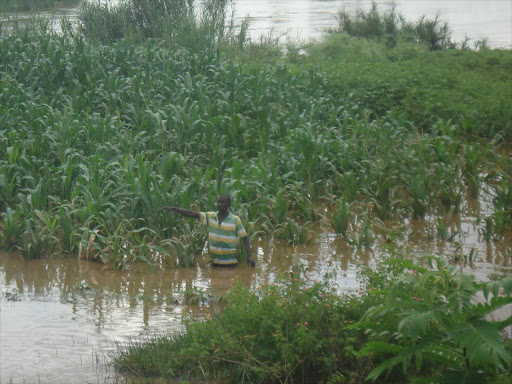AGATHA NGOTHO

Image: FILE/GILBERT OCHIENG
Weather extremes in 2019 were the primary driver of acute food insecurity for 13.2 million people in Kenya, Ethiopia, South Sudan, Sudan, Somalia and Uganda, according to a 2020 food crisis report.
IGAD executive secretary Workneh Gebeyehu said this accounted for about half of the total number of acutely food-insecure people needing urgent assistance.
He said the ongoing floods are coming at a time when the region is facing multiple hazards and shocks including an unpredicted desert locust invasion, Covid-19 pandemic, economic slowdowns and conflict/insecurity among others.
The IGAD report on food crisis released on Wednesday shows that heavy rainfall across East Africa from April has caused severe flooding and landslides. This according to the report led to displacement of people, damaged homes, property, crops, pastures and public infrastructure and further disrupting livelihoods and in some cases leading to death.
“By mid-May, many weather stations had recorded their highest amounts of rainfall in over 40 years, and flooding areas were still recovering from the October–December 2019 floods,” the report indicated.
According to the UN- Office for the Coordination of Humanitarian Affair May report, floods have affected over 1.3 million people across the East Africa region between March and mid-May 2020, with Somalia, Kenya, Ethiopia, Djibouti and Uganda the most affected.
The UN- World Food Programme says over 702 square kilometres of cropland had been washed away or buried by floods across the affected countries in East Africa by early May, and floods were already disrupting the supply and access to food and essential non-food commodities.
The OCHA report indicated that above-average rains have also raised water levels in rivers and lakes, with rivers in several places bursting their banks.
In May, the Devolution ministry reported that water levels have risen in the rivers Nzoia, Lusumu, Yala, Kipsangui, Malakisi, Sio and Malaba and Lake Naivasha, causing displacement and loss of life. Masinga dam has also reached historical levels of 1, 057.56 metres above sea level.
Water and Sanitation CS Sicily Kariuki said about 8,000 acres of land has been destroyed by the floods including acres of matured rice.
So far, more than 200 people in Kenya have died from the heavy rains that have wreaked havoc in some parts of the country.
In Uganda, Lake Victoria, Albert and Kyoga have surpassed their previous record highs, according to authorities, thereby displacing communities close to shorelines and river banks.
The Food and Agriculture Organisation says the bad weather continues to disrupt locust surveillance and control operations in parts of Kenya, Ethiopia and Somalia. The prolonged flooding also raises the risk of outbreaks of livestock diseases, such as Rift Valley fever, and human water-borne diseases such as malaria.
The Kenya Meteorological department says the March to May seasonal rainfall has ceased over several counties in the Northeastern and parts of Southeastern Kenya.
“However, the Lake Victoria Basin, the Highlands West of the Rift Valley, the Central and South Rift Valley, Coastal strip and parts of the Highlands East of the Rift Valley will continue to receive rainfall up to the end of the month of May and into the month of June,” the department said.
The June-July-August weather outlook shows that cases of isolated flooding are still likely in low-lying areas across the country as well as landslides/mudslides in hilly areas of Western and Central Kenya and some parts of the Rift Valley.
“This is particularly due to the fact that the soils are still highly moist and the river and dam levels are still quite high. The expected enhanced rainfall in Western Kenya is likely to provide sufficient soil moisture for agricultural production.” The outlook states.
“However, there is a likelihood of occasional occurrence of frost in parts of the Central Highlands as well as Southern and Central Rift Valley which may affect crop production adversely.”
Source: The Star


